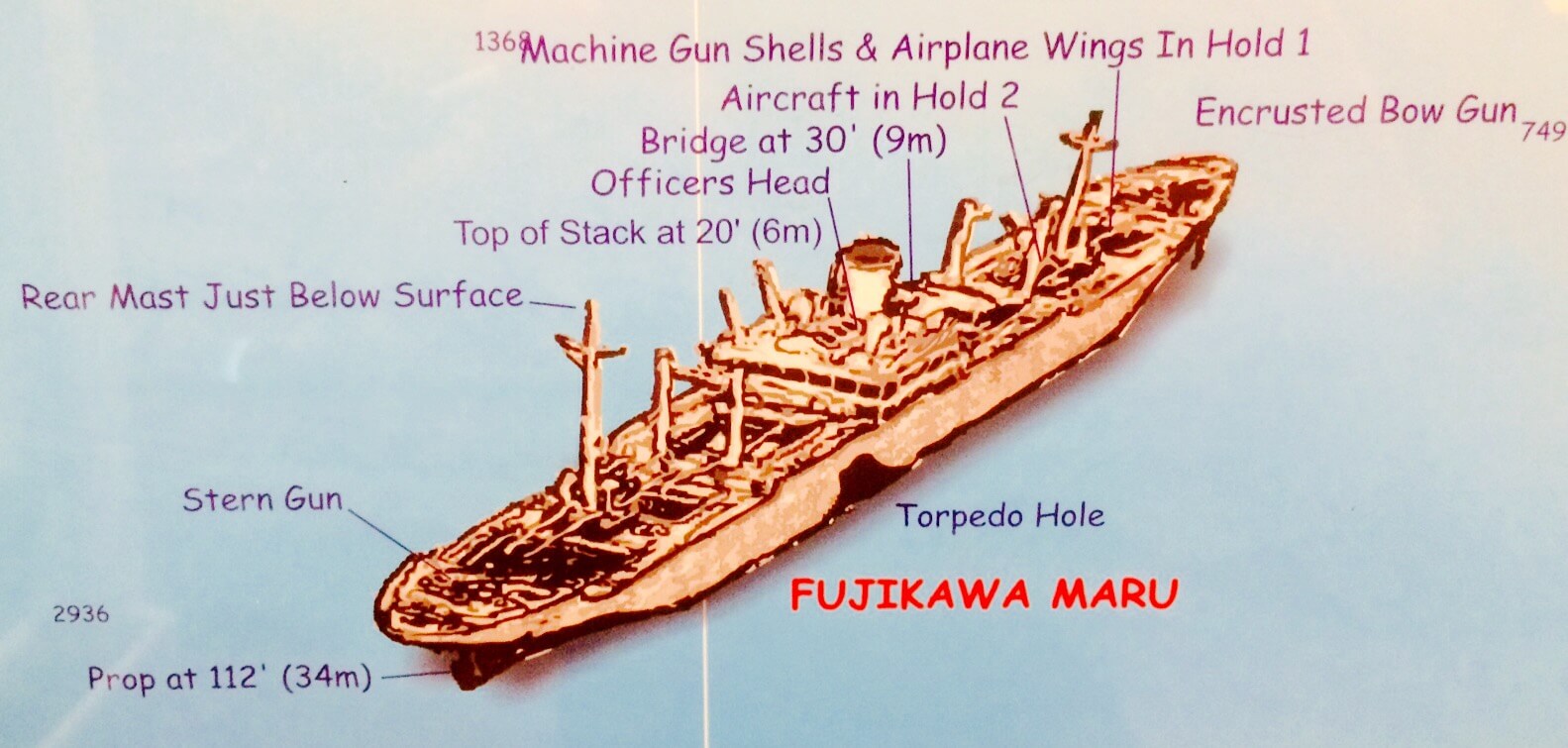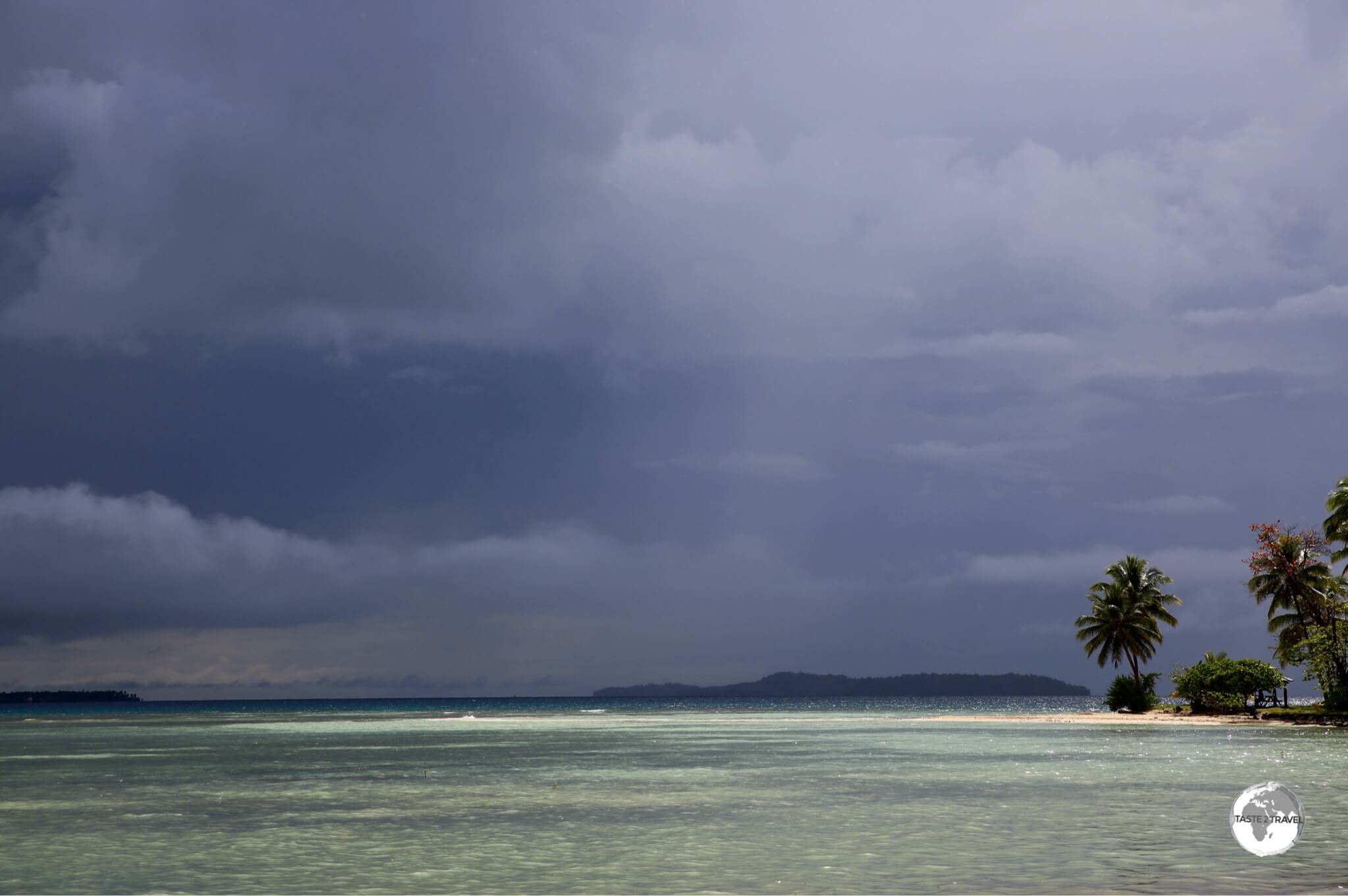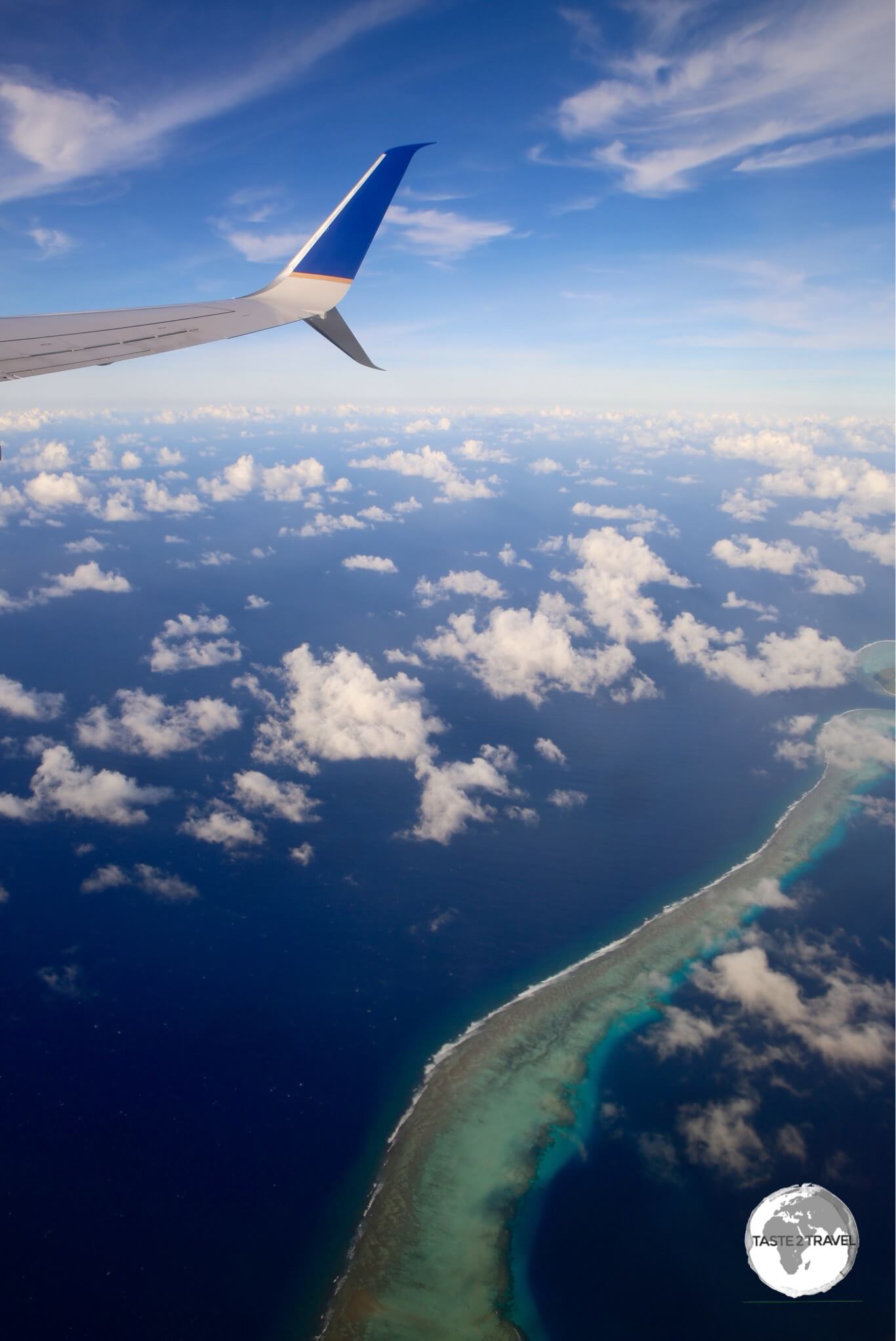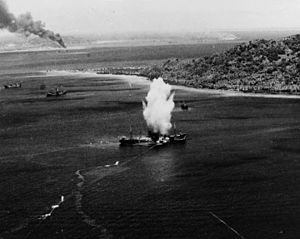Chuuk Travel Guide
Welcome to the taste2travel Chuuk Travel Guide!
Date Visited: February 2017
Introduction
As my torchlight made a sweep of the dark, watery space, I could see five Japanese war planes – Zero bombers – parked side-by-side, disassembled to facilitate transportation. I was 26 metres below the Chuuk lagoon and had just descended into one of the holds of the wrecked Fujikawa Maru. Built in 1938 by the Mitsubishi Company as a passenger and cargo carrier, the Japanese Navy took possession of the Fujikawa in the early days of WWII and converted her into an aircraft ferry.

Fujikawa Maru
Just prior to “Operation Hailstone”, the Fujikawa Maru had arrived in Chuuk where she off-loaded thirty bombers at a Japanese airfield. She would never leave Chuuk and on the day of Operation Hailstone she was still carrying the Zero bombers in her hold – the bombers that I was now diving around.

A shop in downtown Weno, the capital of Chuuk.
Welcome to Chuuk, one of the states of the Federated States of Micronesia (FSM) and the premier wreck diving capital of the world. In other places you can dive a single wreck, on Chuuk you can dive a whole fleet.

Storm clouds over Chuuk Lagoon.
While Chuuk is another beautiful, remote, Pacific atoll, the main reason travellers come here is to dive the plethora of wrecks which lay at the bottom of the lagoon. Chuuk offers world-class wreck diving and with over 60 wrecks, from supply vessels (Maru) to planes and a submarine, there is plenty to keep divers busy.

Truk or Chuuk? What’s in a name? To the Chuukese, their home has always been ‘Chuuk‘. To the Germans (who once colonised the island), Chuuk was difficult to pronounce – to them it sounded like ‘Truuk‘. Once the American GI’s arrived, they pronounced it ‘Truk‘ and that name stuck during the many years that Truk was part of the (US-administered) Trust Territory of the Pacific Islands (TTPI). Following independence, the island reverted back to it’s original name of ‘Chuuk‘.

Stormy skies over Chuuk lagoon.
Location
Chuuk is located north of the equator, between Hawaii and the Philippines. It’s one of the four states of FSM, with the state of Yap to the west and Pohnpei and Kosrae to the east.
Chuuk, Federated States of Micronesia
At a circumference of 225 kilometres (140 mi), the lagoon is the world’s largest – it’s protective barrier reef (the remnants of an ancient volcano) enclose a cluster of small islands, which were once the mountain peaks on the volcano. All services (and infrastructure) are to be found on the administrative island of Weno, with everything being connected by one (not too long), main road.
Weno is the atoll’s capital and, with a population of 12,000 people, is the largest city in the FSM. The outer islands are either uninhabited or contain villagers living a subsistence lifestyle.
History

A Japanese WWII memorial in downtown Weno, Chuuk.
The early history of Chuuk is unknown but it is clear from archaeological digs that people have inhabited the area since the 1st or 2nd century BC. The first recorded sighting of the islands were made by the Spanish in 1528.
The Spanish would later claim the islands (by simply raising a flag) but never established any permanent settlement. In 1899, the Spanish sold the islands to the German empire, but following Germany’s defeat in WWI, the Japanese where given control of the islands under a mandate from the League of Nations.
During WWII, the Japanese used Chuuk as their main Naval base in the South Pacific. From here, they launched operations against Allied forces in the region. Japanese military engineers converted Chuuk into a formidable fortress, with roads, trenches, bunkers, caves, airstrips, seaplane bases, a torpedo boat station, submarine repair shops, a communications centre and a radar station. All of this came to a spectacular, fiery end on February 17, 1944 during Operation Hailstone (see following section).
Following WWII, Chuuk was made one of six districts of the Trust Territory of the Pacific Islands (TTPI), which were administered by the United States under a UN charter. Independence was finally granted to the Federated States of Micronesia (Kosrae, Pohnpei, Chuuk & Yap) in 1990.
More recently, a ‘Chuuk Independence’ movement has gained popularity which, if successful, could see the break up of the FSM.
Operation Hailstone

Operation Hailstone. Source: Wikipedia
If it wasn’t for Operation Hailstone, Chuuk would be just another quiet, remote backwater. On February 17, 1944, the island’s place in history would be ensured forever when American forces commenced a three day bombing campaign, the aim of which was to completely destroy the naval base and all ships in the lagoon.
The relentless aerial bombardment resulted in the sinking of more than 60 warships, planes and a submarine. A 10 minute propaganda film – Yanks Smash Truk (filmed by an embedded cameraman aboard one of the bombers), provides you with a sense of the ferocity of the bombardment.
Diving

A map showing the many Japanese wrecks in Chuuk Lagoon.
As a result of Operation Hailstone, Chuuk lagoon is the world’s largest ship graveyard, with the wrecked Japanese fleet now known as the ‘Ghost Fleet of Truk Lagoon‘. The fleet was first brought to the world’s attention in 1969 when Jacques Cousteau and the Calypso team explored the lagoon and it’s wrecks, producing the TV documentary “Lagoon of Lost Ships“. The documentary put Chuuk on the world diving map and changed the fortunes of the island.
A local diver, Kimiuo Aisek, who as a 17-year-old witnessed Operation Hailstone, opened the islands first dive shop in 1973 at the Blue Lagoon Resort. Today the dive shop is one of two on Weno offering dive trips. A museum at the resort displays artefacts salvaged from some of the wrecks.
Today the island is a magnet for divers with the majority of wrecks being within recreational diving limits (30-40 metres / 100-130 feet) and close to shore. For those who prefer zero commuting to their dive sites, a few live-aboard options are available, these include the SS Thorfin, Odyssey and the Truk Master.

The boat jetty at Truk Stop hotel.
An excellent map of the wreck’s is printed by Franko Map’s (see above image) and is available for purchase on Amazon. The Truk Lagoon Dive Centre offer an online, interactive map, which provides detailed information on various wrecks. I did four dives with Truk Lagoon Dive Centre, these were:
Heian Maru

The Heian Maru wreck which lies at the bottom of Chuuk lagoon.
The largest wreck (11,600 tons) I dived was the giant Heian Maru – this was featured by Jacques Cousteau in his original documentary. Located between 12 metres and 33 metres, the Heian carried supplies for Japanese submarines. We explored inside the forward hold’s, where we saw long lance torpedoes and then into the companionways, where we saw periscopes and other equipment.
Yamagiri Maru

The Yamagiri Maru wreck which lies at the bottom of Chuuk lagoon.
On the Yamagiri Maru (located at a depth of 15 metres – 33 metres) we explored a hold which contained a supply of huge 18.1″ armour piercing shells, with each shell weighing 1,400 kg. Also on-board was a steamroller and other construction equipment.
Fujikawa Maru

The Fujikawa Maru wreck which lies at the bottom of Chuuk lagoon.
Located at a depth of between 9 metres and 34 metres, the Fujikawa Maru is considered the best dive site in Chuuk – this is a ‘must dive’. The main smoke stack is reached at just 6 metres, with her deck at 18 metres. On the bow of the deck is an impressive (coral encrusted), 6-inch (152 mm) bow gun.
In one of the forward hold’s are four disassembled Mitsubishi fighter aircraft along with machine guns, shells and other ammunition. Other structures we explored included the galley, engine room, staterooms, bathrooms and the pilothouse. The entire ship is covered in an abundance of soft corals, which attracts a wealth of marine life. A magical diving experience.
Shinkoku Maru

The Shinkoku Maru wreck which lies at the bottom of Chuuk lagoon.
The Skinkoku Maru is one of the most popular dives in Chuuk. The ship served as a naval tanker and offers a myriad number of rooms (all largely intact) for the diver to explore. The ship was sunk upright with a large bomb hole visible in her port side.
Th ship lies between 12 metres – 38 metres, with her main deck at 18 metres. During the dive we explored the crew quarters, engine room, sick bay, wheelhouse, the galley (complete with porcelain dishes, stove, utensils and other kitchenware) and the deck. The deck is covered in an amazing array of soft corals which attracts a huge amount of fish.
Island Sights

A shop in Weno, the capital of Chuuk.
The terrestrial attractions on Chuuk are limited, which isn’t a problem since most visitors are here for the underwater attractions. A walk along the main street will hold your interest for about 1 hour, during which time you can check out the shops, purchase super cheap local coconut oil (US$2 for a one litre PET bottle) or buy some fresh fruit. All Chuukese ladies wear the traditional Chuukese dress, which are sold in shops along the main street.

A neighbourhood on Weno island flooded after a recent storm.
Outside of town there are some walking trails which will take you up onto the surrounding hilltops. The trails are rough and poorly marked so a local guide is recommended. You can also visit neighbouring atolls for the day, however there are no services or facilities available on these.

A bottle of locally made coconut oil costs US$2 in Weno.
Accommodation

United Airlines’ UA154 on the runway at Chuuk International Airport with my hotel, Hotel Level 5, visible in the background.
There are just a few hotels on Weno, but these are more than enough to cater to the small trickle of travellers who make it here.
Directly opposite the airport is the Level 5 Hotel. I stayed here and I’m glad I did. I visited every hotel on the island and, in my opinion, this is the best. The spacious, comfortable rooms are newly renovated and the ground floor features the best café/ restaurant on the island.
The hotel also features the only elevator on Chuuk but interestingly the locals avoid it – they are either afraid of it or just not use to using one. When it comes time to leave, the airport is across the road. Despite its close proximity to the airport, the hotel offers a shuttle service and will be waiting to pick you up when you arrive – the shortest shuttle connection I’ve ever had.
Also within walking distance of the airport is the High Tide Hotel. This family-run hotel offers older style rooms and a good restaurant, which serves reasonably priced, generous portions of local seafood.

The Truk Stop Hotel at Chuuk, one of the few hotels on Chuuk.
For divers who prefer to stay somewhere with an onsite dive shop, there are two options:
- The closest to downtown is Truk Stop Hotel. This is a family run hotel, whose American owner has been a key proponent of the local tourism (i.e. diving) industry for many years. The 23 hotel rooms are old and dated but a new wing was under construction during my visit (Feb 2017). Besides being home to just one of two dive shops on the island, the hotel offers a restaurant and two bars. If you wish to socialise, this is the only real option on the island.
- The other option, Blue Lagoon Resort, is the most upmarket property on the island and the most expensive, although rooms here are in need of renovation. The resort dive shop was the first established on the island by local diving pioneer Kimiuo Aisek. The resort is located 8 km south of the airport away from the downtown area. The shared ‘town’ taxis (which regularly shuttle along the main road) do not travel this far south (the road is in terrible condition) so you will need to hire a taxi to reach the resort.
Eating Out
Options are limited, with the few hotels providing the only restaurants. My favourite place (and the ‘go to’ place for the best coffee) is the restaurant/ café at the Level 5 Hotel. This is a sister operation of a café in Honolulu and features the only espresso machine on the island. The café is open for breakfast, lunch and dinner and is a popular spot for those waiting for the (often delayed) United Airlines Island Hopper.
The restaurant at Truk Stop Hotel is very popular, with a good selection of food and drinks and always a good ambience. There’s a restaurant at the Blue Lagoon Resort (the only dining option at this end of the island) and at High Tide Hotel.
Visa Requirements

Chuuk Passport Stamps.
Some nationalities require visas for the Federated States of Micronesia – check your visa requirements prior to arrival.
Getting There

United Airlines’ UA154 departing from Chuuk.
By Air

The terminal building at Chuuk International airport.
Flights to Chuuk arrive at Chuuk International Airport on the island of Weno. This sleepy airport is a short walk from the downtown area and several hotels. For more details on UA154 and Chuuk Airport, refer to my Central Pacific Island Hopping blog.

United Airlines’ UA154 departing from Chuuk.
The following airlines provide connections to/from Chuuk:
- Air Niugini – flights to Pohnpei and Port Moresby (with connections onto Australia, Singapore and Manila).
- United Airlines – flights to Guam, Honolulu, Kosrae, Kwajalein, Majuro, Pohnpei

All freight in Micronesia arrives courtesy of two companies – Matson Shipping Line or Asia Pacific Airlines (seen here at Chuuk Airport).
Getting Around
Bus
There are no public buses on Weno.
Taxi
Taxi’s on Weno cost between $1 to $2 depending on distance travelled. The distance from the airport to the Blue Lagoon resort (one end of the island to the other) is about 5 miles.
Car
The Level 5 Hotel offers expensive (US$70 per day) car rental but there’s no need to hire a car on an island with one short road, which is covered by frequent (and cheap) shared taxis.

Chuuk promotes itself as a Diver’s Haven.
That’s the end of my Chuuk Travel Guide.
Safe Travels!
Darren
Follow me on Instagram:
[instagram-feed feed=1]
Further Reading
Other travel reports from the Pacific region:
- American Samoa
- Central Pacific Island Hopping
- French Polynesia
- Galapagos Islands
- Guam
- Kiribati
- Kosrae
- Marshall Islands
- Nauru
- New Caledonia
- Palau
- Papua New Guinea
- Pohnpei
- Samoa
- Solomon Islands
- Tokelau
- Tonga
- Tuvalu
- Vanuatu
Chuuk (Truk) Travel Guide Chuuk (Truk) Travel Guide Chuuk (Truk) Travel Guide Chuuk (Truk) Travel Guide Chuuk (Truk) Travel Guide Chuuk (Truk) Travel Guide Chuuk (Truk) Travel Guide Chuuk (Truk) Travel Guide
Author: Darren McLean
Darren McLean is an Australian, full-time, digital nomad who has spent 37 years on a slow meander around the globe, visiting all seven continents, 192/ 193 UN countries and 245/ 251 UN+ countries and territories.
He founded taste2travel to pique one’s curiosity and inspire wanderlust.







